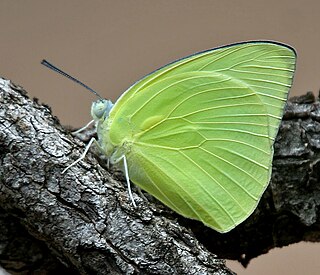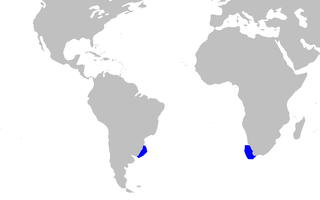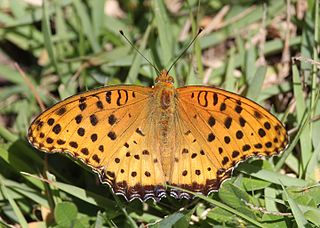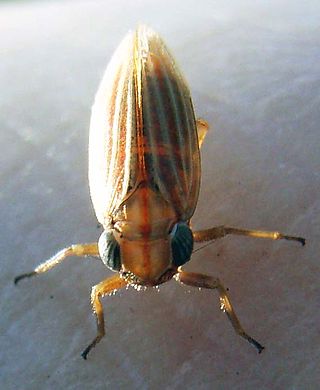
Treehoppers and thorn bugs are members of the family Membracidae, a group of insects related to the cicadas and the leafhoppers. About 3,200 species of treehoppers in over 400 genera are known. They are found on all continents except Antarctica; only five species are known from Europe. Individual treehoppers usually live for only a few months.

Cyrtodactylus jeyporensis, also known as the Jeypore Indian gecko, the Jeypore ground gecko, or the Patinghe Indian gecko, is a endangered species of gecko found in India, which was until recently considered extinct. Described from a single specimen in 1877, it was rediscovered in 2010 in the Eastern Ghats of Odisha state, India.

Catopsilia pomona, the common emigrant or lemon emigrant, is a medium-sized pierid butterfly found in Asia, Cambodia and parts of Australia. The species gets its name from its habit of migration. Some early authors considered them as two distinct species Catopsilia crocale and Catopsilia pomona.

Ant mimicry or myrmecomorphy is mimicry of ants by other organisms. Ants are abundant all over the world, and potential predators that rely on vision to identify their prey, such as birds and wasps, normally avoid them, because they are either unpalatable or aggressive. Spiders are the most common ant mimics. Additionally, some arthropods mimic ants to escape predation, while others mimic ants anatomically and behaviourally to hunt ants in aggressive mimicry. Ant mimicry has existed almost as long as ants themselves; the earliest ant mimics in the fossil record appear in the mid Cretaceous alongside the earliest ants. Indeed one of the earliest, Burmomyrma, was initially classified as an ant.

The Cixiidae are a family of fulgoroid insects, one of many families commonly known as planthoppers, distributed worldwide and comprising more than 2,000 species from over 150 genera. The genera are placed into three subfamilies, Borystheninae, Bothriocerinae and Cixiinae with sixteen tribes currently accepted in Cixiinae.

Castianeira is a genus of ant-like corinnid sac spiders first described by Eugen von Keyserling in 1879. They are found in Eurasia, Africa, and the Americas, but are absent from Australia. Twenty-six species are native to North America, and at least twice as many are native to Mexico and Central America.

Eurybrachidae is a small family of planthoppers with species occurring in parts of Asia, Australia and Africa. They are remarkable for the sophistication of their automimicry.

The taillight shark is a little-known species of shark in the family Dalatiidae and the only member of its genus. It is known from only four specimens collected from deep oceanic waters in the southern Atlantic Ocean and Pacific Ocean. A small shark with a laterally compressed body and a bulbous snout, this species has unusual adaptations that indicate a specialized lifestyle: its pectoral fins are paddle-like and may be used for propulsion, unlike other sharks and it has a pouch-like gland on its abdomen that emits clouds of luminescent blue fluid. This shark is likely aplacental viviparous and a formidable predator for its size.

The Indian fritillary is a species of butterfly of the nymphalid or brush-footed family. It is usually found from south and southeast Asia to Australia.

Dictyopharidae is a family of planthoppers, related to the Fulgoridae. The family comprises nearly 760 species in more than 150 genera which are grouped into two subfamilies, Dictyopharinae and Orgeriinae.

The Indonesian angelshark is a rare species of angelshark, family Squatinidae, known only from a few specimens collected from fish landing sites in southern Indonesia. It is thought to inhabit the deep waters of the continental slope. Reaching at least 1.34 m (4.4 ft) long, this species has a flattened, ray-like shape and a well-developed tail and caudal fin. It is characterized by the absences of fringes on its nasal barbels and thorns down the midline of its back, as well as by its relatively plain grayish-brown dorsal coloration with dark saddles beneath the dorsal fin bases and a black leading margin on the underside of the pectoral fins. The International Union for Conservation of Nature (IUCN) has classified it as Critically Endangered due to significant fishing pressure.
Xenococcus annandalei is a species of mealybug in the family Pseudococcidae that infests the roots of certain species of trees.

Issidae is a family of planthoppers described by Spinola in 1839, belonging to the order Hemiptera, suborder Auchenorrhyncha superfamily Fulgoroidea.

Nogodinidae is a family of planthoppers. They have membranous wings with delicate venation and can be confused with members of other Fulgoroid families such as the Issidae and Tropiduchidae. Some authors treat it as a subfamily of the Issidae. Some of their key features are a frons ("face") that is longer than wide and a reticulate wing venation. They are less than 2 cm long. The antenna arises well below the eye, has the base clubbed and flagellum unsegmented. The lateral ocelli are outside the margins of the face. The face has carinae on the edge. On the hind leg, the second tarsal segment has an apical spine arising from it. The tibia of the hind leg also has spines towards the tip. An important family character is found in the shape of the male genital structure, a style that is longer than broad. Most members of this family are forest species.

Alcathous fecialis is a species of fulgorid planthopper found in southern India. It is the sole species in its genus. It is predominantly brown with dark markings. Its snout curves slightly upward, and its wings are about 3 cm long and hide its short abdomen. From its eyes to the tip of its abdomen, A. fecialis is about 1.2 cm long with a 0.3 cm snout.

Caliscelidae is a family of planthoppers, sap-sucking insects that belong to the order Hemiptera, suborder Auchenorrhyncha and superfamily Fulgoroidea. They are somewhat anomalous and have often been included within the family Issidae. Studies made in 2013 of the phylogeny of the Issidae and other groups using molecular techniques support the treatment of the group as a separate family. Sexual dimorphism can be marked. Some members of the family are called piglet bugs due to the shape of their snout. A particularly aberrant genus described in 2011 from India, Formiscurra, has males that resemble ants.

Agalmatium flavescens is a species of planthopper belonging to the family Issidae, subfamily Issinae.

Formiscurra is a genus of planthopper in the family Caliscelidae with two species: Formiscurra indicus of southern India and Formiscurra atlas from southwestern Ethiopia. Like others of its family they have short wings, suck plant sap and escape by leaping. The species shows great sexual dimorphism. The males of this half centimeter-long insect have an enlarged lobe in front of its head, the frons or metope, giving it an ant-like appearance. Females do not have such an enlarged structure but have a slightly long snout and differ slightly in body shape. The species is found mainly on low vegetation in open scrub and grass habitats. It has been suggested, based on the Afro-Indian distribution, that the ancestral species of this and other genera, Chirodisca and Rhinogaster, evolved in Eurasia and spread to Africa 5-7 million years ago when the Tethys sea closed and thus their ancestors would have been part of the late Miocene Hipparion fauna.

Lycorma imperialis is a planthopper indigenous to parts of China and Indo-Malaysia. L. imperialis was originally discovered in 1846 by Adam White and has one recognized non-nominate subspecies, L. i. punicea. L. imperialis has undergone a number of reclassifications since its discovery and is one of four species in the genus Lycorma. L. imperialis follows a hemimetabolous life cycle and will undergo a series of nymphal stages (instars) before maturing to an adult.

Haaniella gintingi is a stick insect species from Sumatra. It is a typical representative of the subfamily Heteropteryginae. The occasionally used common name Ginting’s Haaniella refers to the species name.





















